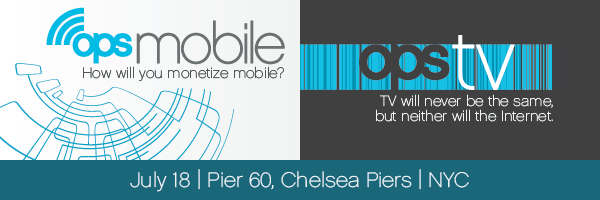
“TV is an immovable object, mobile is an unstoppable force,” suggested Rob Beeler, Content Czar.
A strong opening is essential to a great event, and the content team was having trouble wrapping the myriad topics within the OPS TV/OPS Mobile agenda (Thursday, July 18 at Chelsea Piers in NYC) into a focused introduction worthy of kicking of the day. However, Beeler seemed to be onto something with this analogy to the “irresistible force paradox.”
TV as “unmovable object” certainly fits into the theme of Simulmedia CEO Dave Morgan’s opening keynote. As the founder of TACODA and then Real Media, Dave Morgan has been skating the digital media envelope for about as long the concept of Internet advertising existed. In describing his topic to me, he commented that TV is not going to the web, so much as the web is continually flowing into TV. As the title “Screens in Abundance” suggests, the big challenge is fragmentation – and in recent commentary, Morgan said he doubts we’ll see ad tech companies straddling the linear and digital worlds any time soon.
“The TV video spend, which is tied to the channel bundle and is healthy and growing, is in a relatively bulletproof silo,” he told AdExchanger. “It’s not like newspapers, magazines or Yellow Pages, where they leaked all the money out because it wasn’t healthy. We’re going to see companies that provide infrastructure into them.”
Digital video (on desktop or mobile devices) does not appear to be the great TV slayer once boasted about. In fact, greater spend is going into digital video thanks to metrics such as Nielsen’s OCR and comScore’s VCE, which have bridged the language gap between TV and digital. Of course, this has been in TV buyers’ favor – digital video sellers are doing everything possible to make the holders of the purse strings comfortable working in an unfamiliar arena. And study after study show those digital video budget increases weren’t typically transferred from TV but (gasp!) digital display budgets.
So TV is a rock, TV is a mountain. And device fragmentation is actually building on that mountain, expanding the range. Advertisers realize their audiences are increasingly stretched across devices, so fulfilling their reach (perhaps exceeding it) requires them to invest further in developing channels. Content producers want to meet them and work with them there – in a joint session, News Corp Head of Video Rahul Chopra will join AMC’s Kirk Linden in discussing publisher and broadcaster goals in creating and monetizing compelling content across screens. Check out more of Chopra’s thoughts here.
OPS TV is going to have a fair deal of talk about OTT – also known as over-the-top, this includes platforms such as Apple TV, Roku, Xbox and Playstation. As Xbox increasingly pivots in the direction of family entertainment hub, VP of Senior Busness Development Tom Hennessey will lay out the platform’s monetization opportunities and how it works with content providers like PopcornFlix (represented by Gary Delfiner and Michael Kohn). Later in the day, Aol’s Ran Harnevo will detail why OTT is central to its multiplatform content distribution (and monetization strategy). This was hinted at during Aol’s NewFront presentation back in April.
Then there’s supplementary content – PGA Tour teamed up with long-time sponsor FedEx to bring consumers live streaming across devices of not just broadcasted events, but all its tournaments, big and small. ESPN and ConnecTV will respectively detail broadcasters’ and third-party social networks’ approach to further engaging consumers through second screen initiatives – and then making the revenue pour in.
Mobile worms its way into just about all of these discussions, backing up the notion of an unstoppable force. Beyond its relationship with video – which will be discussed at length during a panel with Neo@Ogilvy, Dyle.tv, YuMe, Smart Ad Server and AdColony – players in the mobile space are increasingly harnessing the inherent technological advantages of portable digital content devices. By this we mean not just experimenting, but creating actual products and strategies.
Take Time’s research into how the time of day affects which device consumers are using to access content. VP of Digital Ad Products and Revenue Ops Adam Solomon will show how Time has integrated this and other insight into multiplatform campaign creation and deployment. On a related note, VivaKi’s The Pool and USA Today will use recent research from the “Tablet Lane” to show how testing and collaboration led them to develop engaging tablet units that were also scalable in a channel flooded with disparate devices and operating systems.
Location data seems to be a major boon regarding mobile devices, but actually applying it effectively (and non-invasively) in advertising products has proved quite the challenge. Representatives from Yelp, Fresh Digital Group and Local Response will respectively provide publisher, agency and service provider case studies of putting location data to work, while also pondering the future potential.
So TV may be an immovable object while mobile is an unstoppable force, but note that in digital advertising these two aren’t coming to a head. They’re moving together, criss-crossing like a pair of figure skaters. Will mobile ever become the rock that TV is? Is there anything that could shake the seemingly impenetrable foundation of TV?
Those questions may not be answered as OPS TV and OPS Mobile on July 18, but attendees will certainly stock up on enough ammunition to further the debate. We hope that includes you.